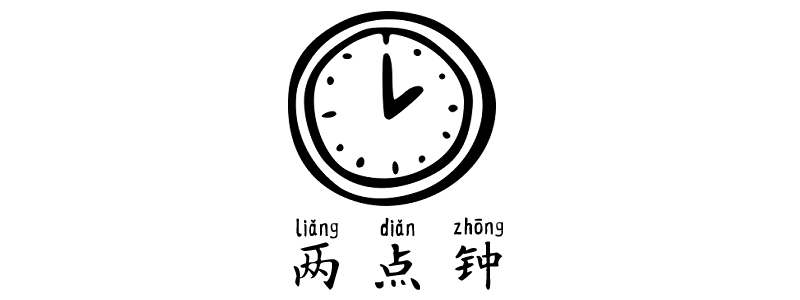Grammar Point:
In Mandarin Chinese, time is expressed by stating the hour first, followed by the minute, in a “big to small” order, just like in English.
Time
Hour + 點/点 diǎn + Minute + 分 fēn
When expressing the time, you can use the structure mentioned above to indicate a specific time. However, if you specifically want to emphasize “o’clock” in Chinese, using 点钟 diǎnzhōng after the hour is a common way to do so.
5:50 – 五點五十分五点五十分
4:00 – 四點 or 四點鐘四点 or 四点钟
3:02 – 三點零二分三点零二分
(when expressing minutes below 10, it is common to add a leading zero. This helps to clarify and ensure clarity when indicating the exact minute.)
11:01 – 十一點零一分十一点零一分
2:18 – 兩點十八分两点十八分
(When expressing “Two o’clock” in Chinese, it is customary to use the term 两 liǎng instead of 二 èr. This is a special case in Chinese where 两 liǎng is used specifically for counting hours.)
12:15 – 十二點十五分十二点十五分
9:00 – 九點 or 九點鐘九点 or 九点钟
In spoken Chinese, it is common to omit the term 分 fēn when expressing minutes to make the sentence shorter and more efficient, but this is typically done only when the minutes are greater than 11.
7:24 – 七點二十四七点二十四
10:19 – 十點十九十点十九
現在幾點?现在几点?
What time is it now?
Half and Quarter
半 bàn
This is the term used to express “half” in Chinese.
7:30 – 七點半七点半
12:30 – 十二點半十二点半
刻 kè
This is the term used to express “quarter” in Chinese, but Taiwanese do not commonly use it. Instead, we prefer to say 15 分 fēn or 45 分 fēn to indicate a quarter of an hour..
2:15 – 兩點一刻两点一刻
8:45 – 八點三刻八点三刻
Minutes to the Hour
差 + Minutes + 分 + Hour + 點/点
Hour + 點/点 + 差 + Minutes + 分
差 chà means “to be short of” or “to lack.” It indicates that there is a time difference or remaining time until a certain hour.
5:55 – 差五分六點差五分六点
9:59 – 十點差一分十点差一分
11:28 – 差兩分十一點半差两分十一点半
A.M and P.M
Since the 24-hour system is not commonly used in Chinese time expression, the distinction between A.M. and P.M. becomes significant. However, in reality, Chinese does not have specific designations for A.M. and P.M. Instead, time is divided into seven periods. It is important to note that these periods are placed in front of the time when expressing it in Chinese.
- 早上早上:05:00~09:00 ish (early morning)
- 上午上午:09:00~12:00 ish (morning)
- 中午中午:12:00 ish (noon)
- 下午下午:13:00~18:00 ish (afternoon)
- 晚上晚上:18:00~00:00 ish (night)
- 半夜半夜:00:00~3:00 ish (midnight)
- 凌晨凌晨:3:00~5:00 ish (before dawn)
我每天早上七點起床我每天早上七点起床
I wake up at 7 o’clock every morning.
晚上十一點半睡覺晚上十一点半睡觉
I go to bed at 11:30 p.m. in the evening.
下午三點一刻喝下午茶下午三点一刻喝下午茶
I have afternoon tea at a quarter past three in the afternoon.
半夜兩點不睡覺,你在做什麼?半夜两点不睡觉,你在做什么?
I don’t sleep at 2 o’clock in the middle of the night. What are you doing?
我今天上午有中文課我今天上午有中文课
I have Chinese class this morning.
Practice
TouchHover over the space to see the answers.
✔️ 12:00
中午十二點中午十二点
✔️ 17:30
下午五點半下午五点半
✔️ 03:15
凌晨三點一刻凌晨三点一刻
- Days in Chinese (HSK 1)
- Dates in Chinese (HSK 1)


